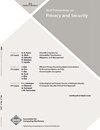Spoofing Against Spoofing: Towards Caller ID Verification In Heterogeneous Telecommunication Systems
IF 2.8
4区 计算机科学
Q2 COMPUTER SCIENCE, INFORMATION SYSTEMS
引用次数: 0
Abstract
Caller ID spoofing is a global industry problem and often acts as a critical enabler for telephone fraud. To address this problem, the Federal Communications Commission (FCC) has mandated telecom providers in the US to implement STIR/SHAKEN, an industry-driven solution based on digital signatures. STIR/SHAKEN relies on a public key infrastructure (PKI) to manage digital certificates, but scaling up this PKI for the global telecom industry is extremely difficult, if not impossible. Furthermore, it only works with IP-based systems (e.g., SIP), leaving the traditional non-IP systems (e.g., SS7) unprotected. So far the alternatives to the STIR/SHAKEN have not been sufficiently studied. In this paper, we propose a PKI-free solution, called Caller ID Verification (CIV). CIV authenticates the caller ID based on a challenge-response process instead of digital signatures, hence requiring no PKI. It supports both IP and non-IP systems. Perhaps counter-intuitively, we show that number spoofing can be leveraged, in conjunction with Dual-Tone Multi-Frequency (DTMF), to efficiently implement the challenge-response process, i.e., using spoofing to fight against spoofing. We implement CIV for VoIP, cellular, and landline phones across heterogeneous networks (SS7/SIP) by only updating the software on the user’s phone. This is the first caller ID authentication solution with working prototypes for all three types of telephone systems in the current telecom architecture. Finally, we show how the implementation of CIV can be optimized by integrating it into telecom clouds as a service, which users may subscribe to.欺骗对抗欺骗:异构电信系统中的来电显示验证
来电显示欺骗是一个全球性的行业问题,经常成为电话欺诈的关键促成因素。为了解决这个问题,美国联邦通信委员会(FCC)要求美国的电信提供商实施STIR/SHAKEN,这是一种基于数字签名的行业驱动解决方案。STIR/SHAKEN依赖于公钥基础设施(PKI)来管理数字证书,但是为全球电信行业扩展这个PKI是极其困难的,如果不是不可能的话。此外,它只适用于基于ip的系统(例如SIP),而传统的非ip系统(例如SS7)则不受保护。到目前为止,搅拌/震动的替代方法还没有得到充分的研究。在本文中,我们提出了一个无pki的解决方案,称为来电显示验证(CIV)。CIV基于质询-响应过程而不是数字签名来验证呼叫者ID,因此不需要PKI。它支持IP和非IP系统。也许与直觉相反,我们表明数字欺骗可以与双音多频率(DTMF)结合使用,以有效地实现挑战响应过程,即使用欺骗来对抗欺骗。我们通过仅更新用户手机上的软件来实现跨异构网络(SS7/SIP)的VoIP、蜂窝电话和固定电话的CIV。这是第一个具有适用于当前电信体系结构中所有三种类型电话系统的工作原型的呼叫者ID身份验证解决方案。最后,我们展示了如何通过将CIV作为服务集成到用户可以订阅的电信云中来优化CIV的实现。
本文章由计算机程序翻译,如有差异,请以英文原文为准。
求助全文
约1分钟内获得全文
求助全文
来源期刊

ACM Transactions on Privacy and Security
Computer Science-General Computer Science
CiteScore
5.20
自引率
0.00%
发文量
52
期刊介绍:
ACM Transactions on Privacy and Security (TOPS) (formerly known as TISSEC) publishes high-quality research results in the fields of information and system security and privacy. Studies addressing all aspects of these fields are welcomed, ranging from technologies, to systems and applications, to the crafting of policies.
 求助内容:
求助内容: 应助结果提醒方式:
应助结果提醒方式:


